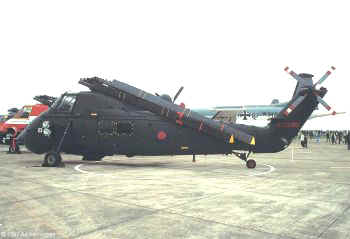Westland Wessex HAS.3, XM328
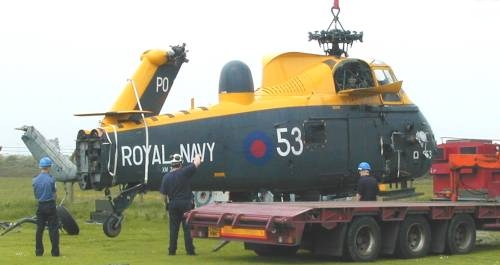 |
||
| Westland Wessex HAS.3, XM328, c/n WA9, went on pre-restoration public display at The Helicopter Museum, just over two years after delivery (above) by MASU in May 2004. It was built at Yeovil in 1959 as a pre-production HAS.1 anti-submarine warfare helicopter for the Royal Navy, powered by one 1450 shp Napier Gazelle NGa.13 Mk.161 turboshaft engine. The HAS.1 was the world's first free-turbine engine aircraft to go into quantity production. It was fitted with dunking sonar, Doppler radar navigation, partial auto-stabilisation and Louis Newmark Mk.19 autopilot facilities. The new Flight Control System allowed the HAS.1 to hover over the sea at night or in bad visibility. Previously this could only be done when the pilot had a visual horizon as a reference. | ||
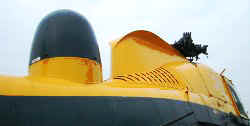 |
Between 1965 and 1968 forty-three HAS.1s, including XM328, were upgraded to Mk.3 specification. This included a new search radar in a dorsal dome (left), causing the type to be known as the 'Camel', full flight control systems, duplicated autostabilisation, a new medium-depth sonar system and substitution of the 1600 shp Gazelle NGa.22 Mk.165 turboshaft engine. |
| The Museum already has a Mk.3 Wessex, XS149, but this is not in such a good condition, or as complete, as XM328 and would have taken much longer to restore to display condition. XS149 will probably be sold or traded for another airframe. | |
 |
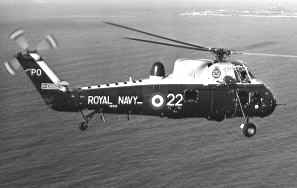 |
|
| Wessex HAS.1 XM328 (left) in 1960 and (right) soon after HAS.3 configuration upgrade. | ||
| XM328
spent the first years of its life, while still a Mk.1, engaged in radio, instrument and
other flight performance trials, including some at A & AEE Boscombe Down, with ten
other pre-production examples. Later, from 1970, it was stationed at Portland, in Dorset, with 737 Naval Air Squadron where, as an HAS.3, it was assigned to operate from the stern platforms of several of the six County Class guided missile destroyers, including HMS Glamorgan and HMS Norfolk. Wessex HAS.3s equipped seven flights on these destroyers in addition to an aircrew training squadron at RNAS Portland. In
their shipborne, anti-submarine role, the HAS.3s could carry two Mk.44 or Mk.46 homing
torpedoes (with parachutes) or four Mk.11 depth charges in addition to their Plessey
dipping sonar. They could also be fitted with a door-mounted machine gun and act as a
self-contained unit, handling all operations at the scene of an anti-submarine action. |
||
| In 1984, after a short
time in storage at Wroughton, XM328 was transferred to RNAS Culdrose,
in Cornwall. There, for the next twenty years, it was used as
a ground training aircraft, by the School of Aircraft Handling,
(more recently, the School of Flight Deck Operations), which teaches
the skills of moving and securing aircraft on flight decks and
in hangars.
XM328 as seen (right) at RNAS Culdrose in July 1997.
|
|
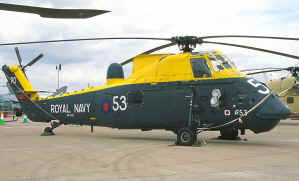 |
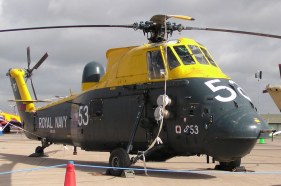 |
|
| In July 2003, XM328, in anti-submarine
colour scheme, was loaned, by RNAS Culdrose, for display at the
Royal International Air Tattoo, Fairford (above), but was
declared surplus by the MoD, in early 2004 and purchased by The
Helicopter Museum. Thanks for photographs (left) © Stephen Boreham and (right) © Ben Clements, both seen on Airliners.net |
||
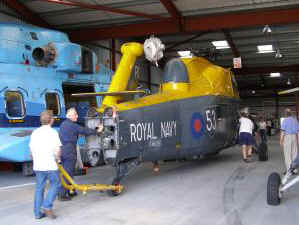 |
 |
|
| On 17th June 2006, after two years exposure to the weather, XM328 was brought into the main Display Hangar (above) but, on 23rd June 2007, was transferred to the new hangar extension area which is not open to the public. However the HAS.3 can still be seen through the (normally open) doorway, as conservation work continues. | ||
 |
The Wessex is largely complete although the instrument panel and a lot of the cockpit interior fittings were missing. Much of the cabin equipment remains, including some of the internal winch mechanism used for raising and lowering the sonar buoy. A rapid structural survey of the interior and exterior had been carried out, in the main hangar, while the machine was on display. | |
| Most of the autopilot, auto-stabilisation,
sonar and other avionics units were labelled and removed, prior
to cleaning and corrosion treatment. The outside of the aircraft
was washed to allow closer inspection of the skin, where some rivets
have been found to be suffering from corrosion. Some small areas
of skin needed replacement. In early 2007 the weapon pylons were
refurbished and painted. Later in 2007, following XM328's move into the newly-completed Engineering Hangar, most of the remaining cabin equipment was removed. After cleaning and anti-corrosion treatment, where necessary, parts of the interior were re-painted. |
||
| Wessex HAS.3, XM328, Restoration | ||
| Falklands Anniversary | ||
